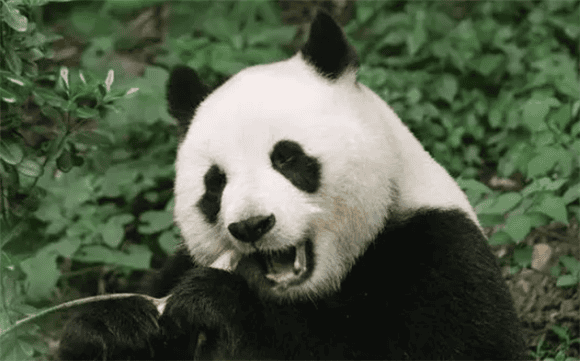The giant panda is a rare mammal with black and white fur, round cheeks, large "dark circles" under the eyes, a signature pigeon-toed walking style, and scalpel-like sharp claws. It lives in the mountainous areas of Sichuan, Shaanxi and Gansu in China and feeds on bamboo as its staple food. It is known as a "living fossil" and "China's national treasure". So, are giant pandas cats? This article will explore this issue from the following aspects.

1. Classification of giant pandas
Giant pandas belong to the class Mammalia, order Carnivora, family Ursidae, and genus Ursus. Its scientific name is Ailuropoda melanoleuca. It has two subspecies, namely the Sichuan giant panda and the Qinling giant panda.
The classification of the giant panda has been controversial because it has characteristics of both a bear and a raccoon. However, molecular biology research shows that giant pandas do not belong to the cat family, but to the Ursidae family along with other bears (such as brown bears, black bears, polar bears, etc.).
2. Morphological characteristics of the giant panda
The giant panda is plump and plump like a bear, with a round head and short tail. The head and body are 1.2-1.8 meters long, and the tail is 10-12 meters long. centimeter. Weighing 80-120 kg, the heaviest can reach 180 kg. Its skin is thick, up to 10 mm at its thickest point. Its fur color is black and white. Its cheeks are round and there are big "dark circles" under its eyes, giving people a cute and honest impression. Its ears are small and round, its nose is flat, and its mouth is small and narrow. Its eyes are small, round, and dark brown. It has well-developed teeth and particularly wide molars, suitable for chewing bamboo. Its tongue is long and thick, with many small spines on its surface, which can help peel the outer skin of bamboo. In addition to the five toes, its claws also have a "thumb", which is actually a specialized wrist bone and is mainly used to hold bamboo. Its toenails are sharp and curved, helping it climb trees or dig in the soil. The bottoms of its feet are hairy to increase friction and warmth.
It can be seen from these morphological characteristics that giant pandas have many things in common with other carnivores, but there are also some differences. For example, its "thumb" is a special evolutionary adaptation that allows it to better grip bamboo. Its coat color is also a hidden protective color, which makes it difficult to be discovered by natural enemies on the trees in dense forests and on the snowy ground.
3. Living habits of giant pandas
Giant pandas are solitary animals and rarely have contact with their own kind except during the mating and nurturing periods. Its activity range is generally 5-10 square kilometers, sometimes changing depending on the growth of bamboo. Its active time is mainly in the early morning, evening and night, and it sleeps most of the day. It is good at climbing trees and loves to play. The behavior of climbing trees is generally a way for the weak to avoid the strong when the marriage proposal is approaching, or to escape danger, or when they meet each other. It may also use urine, feces, or glandular secretions to mark its territory or information. Its calls are diverse, including bleating, hissing, roaring, grunting, etc., which can express different emotions and intentions.
Giant pandas are omnivores, but 99% of their food is bamboo. There are more than 60 species of bamboo plants in 12 genera that can be eaten by giant pandas. It eats 12-38 kilograms of bamboo every day, accounting for 12-38% of its body weight. Due to the low nutritional value of bamboo, giant pandas must consume large amounts of bamboo to maintain their lives. Therefore, it spends 10-16 hours a day eating, and most of the remaining time is spent resting and digesting. In addition to bamboo, giant pandas occasionally eat other plants (such as grass, flowers, fruits, etc.) or animals (such as birds, mice, insects, etc.), but these only account for 1% of their food.
The giant panda is a dioecious animal, that is, females and males have obvious external characteristics. Males are slightly larger than females, and the "dark circles" on males are deeper and larger than on females. Males also have a prominent baculum that aids in mating. The mating period of giant pandas is generally between March and May every year. Females only have estrus for 2-7 days. During this period, they will actively look for males and make special calls to attract males. Males will fight fiercely for females, and the winner will mate with the female. After mating, the female will enter a pseudopregnancy period ranging from 45 to 163 days, during which she will show signs of pregnancy, such as loss of appetite, reduced activity, and swollen breasts. But only a small percentage actually get pregnant and give birth. This is because giant pandas have a special reproductive phenomenon called "delayed embryo implantation." That is, the fertilized egg stops developing in the body for a period of time until the mother's conditions are suitable before implanting and continuing to develop.
4. Reproduction and protection of giant pandas
The reproductive capacity of giant pandas is very low. They usually only give birth to one cub per litter, and occasionally give birth to two cubs, but they can often only feed one. . Giant panda cubs are very weak when they are born, weighing only 100-200 grams, which is equivalent to 1/900-1/1000 of the mother's body weight. They are hairless, their skin is pink, their eyes are closed, their ears are floppy, their limbs are weak, and they can only make weak calls. They rely on their mothers for suckling and protection, and cannot be weaned until they are 6-8 months old, and are not fully independent until they are 18-24 months old. The sexual maturity period of giant pandas is generally 4-5 years old, and their life span is 18-20 years old in the wild, and can exceed 30 years old in captivity.
The giant panda is one of the rarest animals in the world and a flagship species for world biodiversity conservation. It is not only China's national treasure, but also the world's common wealth. Its existence is of great significance for maintaining ecological balance and protecting biological diversity. However, due to over-exploitation and destruction by humans, giant pandas face many threats, such as habitat loss and fragmentation, death of bamboo flowers, predation by natural enemies, poaching and trafficking, genetic loss and disease. These threats have led to a sharp decline in the number of giant pandas and population fragmentation. According to statistics, there are currently only about 1,864 wild giant pandas and more than 600 captive giant pandas in the world.

In order to save this endangered species, the Chinese government and the international community have adopted a series of protection measures, such as establishing nature reserves, implementing artificial breeding and reintroduction plans, carrying out scientific research and education and publicity, and strengthening international cooperation and exchanges. These measures have achieved certain results, causing the number of giant pandas to increase and stabilize, and the quality of the population to improve. On September 4, 2016, the World Conservation Union (IUCN) downgraded the giant panda from the "Endangered" (EN) level to the "Vulnerable" (VU) level. In 2021, the State Council released the "List of National Key Protected Wild Animals (2021 Edition)", downgrading the panda from a national first-level protected animal to a national second-level protected animal. This is an affirmation and encouragement for the protection work of giant pandas.
However, this does not mean that the giant panda is safe. It remains a highly threatened species, facing many uncertain risks and challenges. For example, climate change may cause the distribution range of bamboo to shrink or change, affecting the food source of giant pandas; population growth and economic development may lead to further loss or fragmentation of habitat, affecting the activity space and genetic exchange of giant pandas; human interference and activities may cause The stress and discomfort of giant pandas affect their physical and mental health. Therefore, we cannot take it lightly and must continue to strengthen the protection of giant pandas and create a good living environment for them so that they can thrive and stay with us forever.

 扫一扫微信交流
扫一扫微信交流
发布评论